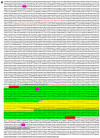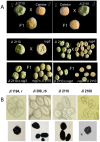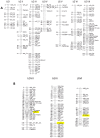Genetic Variation Controlling Wrinkled Seed Phenotypes in Pisum: How Lucky Was Mendel?
- PMID: 28587311
- PMCID: PMC5486028
- DOI: 10.3390/ijms18061205
Genetic Variation Controlling Wrinkled Seed Phenotypes in Pisum: How Lucky Was Mendel?
Abstract
One of the traits studied by Mendel in pea (Pisum sativum L.) was the wrinkled-seeded phenotype, and the molecular basis for a mutation underlying this phenotype was discovered in the 1990s. Although the starch-branching enzyme gene mutation identified at the genetic locus r is most likely to be that in seeds available to Mendel in the mid-1800s, it has remained an open question as to whether or not additional natural mutations in this gene exist within Pisum germplasm collections. Here, we explore this question and show that all but two wrinkled-seeded variants in one such collection correspond to either the mutant allele described previously for the r locus or a mutation at a second genetic locus, rb, affecting the gene encoding the large subunit of Adenosine diphosphoglucose (ADP-glucose) pyrophosphorylase; the molecular basis for the rb mutation is described here. The genetic basis for the phenotype of one (JI 2110) of the two lines which are neither r nor rb has been studied in crosses with a round-seeded variant (JI 281); for which extensive genetic marker data were expected. In marked contrast to the trait studied by Mendel and the rb phenotype; the data suggest that the wrinkled-seeded phenotype in JI 2110 is maternally determined, controlled by two genetic loci, and the extent to which it is manifested is very sensitive to the environment. Metabolite analysis of the cotyledons of JI 2110 revealed a profile for sucrose and sucrose-derived compounds that was more similar to that of wild-type round-seeded, than that of wrinkled-seeded r, pea lines. However, the metabolite profile of the seed coat (testa) of JI 2110 was distinct from that of other round-seeded genotypes tested which, together with analysis of recombinant inbred progeny lines, suggests an explanation for the seed phenotype.
Keywords: genetic markers; myoinositol; pea germplasm; r and rb mutations; seed coat (testa) metabolites; seed phenotype; wrinkled seeds.
Conflict of interest statement
The authors declare no conflict of interest.
Figures







Similar articles
-
A Suite of Pea (Pisum sativum L.) Near-Isolines: Genetic Resources and Molecular Tools to Breed for Seed Carbohydrate and Protein Quality in Legumes.Int J Mol Sci. 2025 Mar 14;26(6):2612. doi: 10.3390/ijms26062612. Int J Mol Sci. 2025. PMID: 40141254 Free PMC article.
-
Characterization and structural analysis of wild type and a non-abscission mutant at the development funiculus (Def) locus in Pisum sativum L.BMC Plant Biol. 2009 Jun 23;9:76. doi: 10.1186/1471-2229-9-76. BMC Plant Biol. 2009. PMID: 19549315 Free PMC article.
-
Proteomics analysis of round and wrinkled pea (Pisum sativum L.) seeds during different development periods.Proteomics. 2025 Feb;25(3):e2300363. doi: 10.1002/pmic.202300363. Epub 2024 Oct 30. Proteomics. 2025. PMID: 39475056 Free PMC article.
-
The importance of starch biosynthesis in the wrinkled seed shape character of peas studied by Mendel.Plant Mol Biol. 1993 Jun;22(3):525-31. doi: 10.1007/BF00015981. Plant Mol Biol. 1993. PMID: 8329688 Review.
-
Differentiation of legume cotyledons as related to metabolic gradients and assimilate transport into seeds.J Exp Bot. 2003 Jan;54(382):503-12. doi: 10.1093/jxb/erg051. J Exp Bot. 2003. PMID: 12508061 Review.
Cited by
-
NMR Metabolomics Defining Genetic Variation in Pea Seed Metabolites.Front Plant Sci. 2018 Jul 17;9:1022. doi: 10.3389/fpls.2018.01022. eCollection 2018. Front Plant Sci. 2018. PMID: 30065739 Free PMC article.
-
Improving pulse crops as a source of protein, starch and micronutrients.Nutr Bull. 2019 Sep;44(3):202-215. doi: 10.1111/nbu.12399. Epub 2019 Aug 22. Nutr Bull. 2019. PMID: 31598097 Free PMC article. Review.
-
Variation in Pea (Pisum sativum L.) Seed Quality Traits Defined by Physicochemical Functional Properties.Foods. 2019 Nov 13;8(11):570. doi: 10.3390/foods8110570. Foods. 2019. PMID: 31766191 Free PMC article.
-
Physiological and molecular aspects of seed longevity: exploring intra-species variation in eight Pisum sativum L. accessions.Physiol Plant. 2022 May;174(3):e13698. doi: 10.1111/ppl.13698. Physiol Plant. 2022. PMID: 35526223 Free PMC article.
-
A Suite of Pea (Pisum sativum L.) Near-Isolines: Genetic Resources and Molecular Tools to Breed for Seed Carbohydrate and Protein Quality in Legumes.Int J Mol Sci. 2025 Mar 14;26(6):2612. doi: 10.3390/ijms26062612. Int J Mol Sci. 2025. PMID: 40141254 Free PMC article.
References
-
- Wang T.L., Bogracheva T.Y., Hedley C.L. Starch: As simple as A, B, C? J. Exp. Bot. 1998;49:481–502. doi: 10.1093/jxb/49.320.481. - DOI
-
- Mendel G. Versuche über pflanzen-hybriden. Verhandlungen des Naturforschenden Vereines in Brünn. 1866;4:3–47.
-
- Wang T.L., Hedley C.L. Seed development in peas: Knowing your three “r’s” (or four, or five) Seed Sci. Res. 1991;1:3–14. doi: 10.1017/S096025850000057X. - DOI
MeSH terms
Substances
Grants and funding
LinkOut - more resources
Full Text Sources
Other Literature Sources

